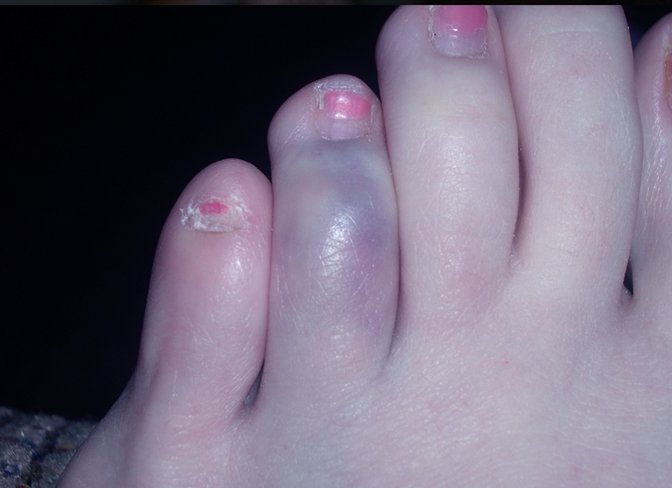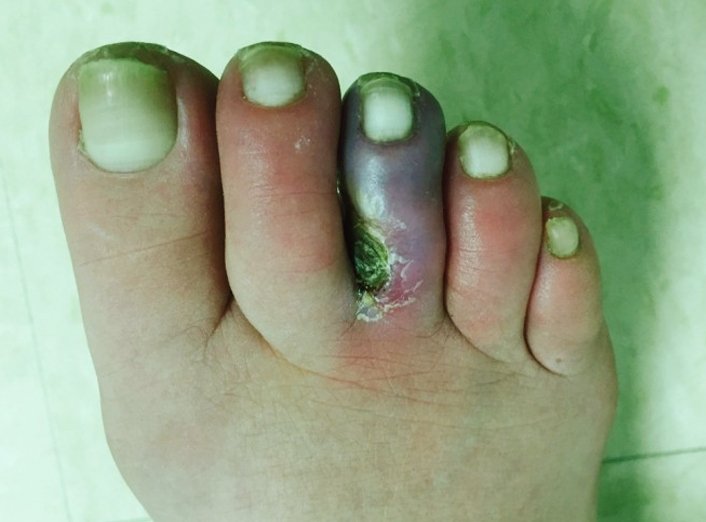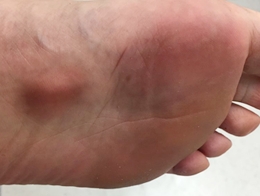Blue Toe Syndrome
What is Blue Toe Syndrome?

Blue toe syndrome or gray toe syndrome or purple toe syndrome refers to discoloration of the toenails, causing them to take on a blue hue or a colour that closely resembles blue. The blue-ish discoloration is often a result of tissue death, following impaired circulation. It may affect one toe or many toes. However, blue toe nails are not exclusively found in blue toe syndrome and thus, they may be an indicator of other conditions. It is important to note that the presence of blue toe nails whose cause can be attributed to other diseases, trauma or extremely cold weather, rules out the possibility of blue toe syndrome.
Symptoms
Blue toe syndrome commonly affects the elderly population, with a small prevalence in those who are under the age of fifty years. Its symptoms include:
- Blue toes: These are also called cyanotic toes. The discoloration is usually very rapid.
- Presence of foot pulses: This is a bit of a paradox since an absent pulse represents compromised circulation. However, the presence of foot pulses in a person with blue toe nails does not rule out a vascular cause of the syndrome.
- Pain: The blue-ish discoloration is often accompanied by excruciating pain. This pain may be felt only in the foot, or even in parts above the foot.
- Skin discoloration: Blue toe syndrome may also present with discoloration of the skin, often in a lace-like pattern.
- Swelling: There may be swelling of the toes and feet. This is often mild, but can be severe.
What Causes Blue Toe Syndrome?
There are several causes of blue toe syndrome. All these causes work through either one of the following three mechanisms:
- Decreased flow of blood into the tissues of the foot
- Reduced flow of blood from the tissues of the foot
- Presence of abnormalities in the blood circulation.
The end product of any of the above mechanisms is reduced delivery of nutrients and oxygen to the foot, so that there is increased tissue death and destruction. The blue color of the nails is often due to reduced delivery of oxygen and tissue death. The causes include:
Occlusion of the arteries or veins around the foot due to an embolus
An embolus refers to an abnormal or foreign material that flows through the blood vessels and may lodge in one of the vessels. In the case of blue toe syndrome, the most common emboli are atheromatous plaques. These are plaques formed through deposition of fat along the blood vessel wall. These plaques may dislodge and travel through the bloodstream as emboli. This may result in blockage of the vessels affected, preventing flow of blood through the arteries, or outflow of blood through the veins.
Aneurysms
An aneurysm refers to the presence of an out pouching along the vessel wall. This develops particularly at an area of weakness on the wall of a blood vessel. Aneurysms are at increased risk of rupture. Aneurysms usually represent a problem in circulation of blood. Moreover, due to the pooling of blood at the area of the out-pouching, there may be reduced blood flow into or out of the foot.
Cardiovascular manipulations
This is mostly tied to the presence of emboli. In people, especially the elderly, any manipulation of the heart or blood vessels may result in dislodging of an emboli and consequently blocking blood vessels.
Other causes include:
- Treatment using anticoagulants or thrombolytic medications. This is usually a common cause of relapse in people who had been successfully treated for blue toe nails.
- Secondary syphilis
- Disseminated Intravascular Coagulation
- Infections – These are most often associated with recent childbirth or surgery.
- Pheochromocytoma
- Pancreatitis
Diagnosis
Blue toe syndrome is often incorrectly diagnosed owing to the fact that the discoloration seen in this condition may be present in many other conditions. Additionally, the change in the color of toes and the toenails may be a result of trauma. The presence of the pulses of the foot makes it even harder to make a correct diagnosis.
A doctor should take a complete and thorough history to identify if there are any factors that can rule out the blue toe syndrome. For example, they may explore trauma as a cause, but in the absence of trauma look for pointers to other conditions that cause cyanotic toes. Following the history taking process, the doctor should then proceed to examine the affected toe. To aid the diagnostic process, several tests and procedures may be done. These include, CT scans and ultrasound, full thickness skin biopsy (this is done particularly for those who have skin discoloration) and vascular assessment. Diagnosis aims to find the underlying cause of the blue toe syndrome. This enables a directed treatment as some of the causes are treated through surgery and others show improvement without surgical intervention.
Pictures
Pictures of Blue Toe Syndrome:

Treatment
As stated above, some causes of blue toe syndrome require surgery while others can be treated using medication. One of the causes for which surgery is recommended is aneurysms. Surgeries can also be done to prevent dislodging of atheromatous plaques or to remove the embolized plaques, although this is often not recommended. The specific surgeries performed in blue toe syndrome include bypass surgery which involves developing a shunt that connects the two normal parts of the blood vessel thereby by-passing the abnormal part, and endarterectomy which involves removal of atheromatous plaques or emboli.
Medical treatment is quite often in the form of what can be loosely termed as home remedies. These include getting enough rest, taking enough water, keeping warm, and in some cases it may involve taking medication. This is often recommended in the case of blood vessel occlusion due to embolization. Medication includes pain medication to alleviate the pain. It also includes use of anticoagulant drugs, for example aspirin-which also serves as a pain medication. Corticosteroids may also be used in the case of embolization. Medical treatment may also come in handy in the treatment of underlying conditions which may result in blue toe syndrome including pancreatitis and syphilis.







